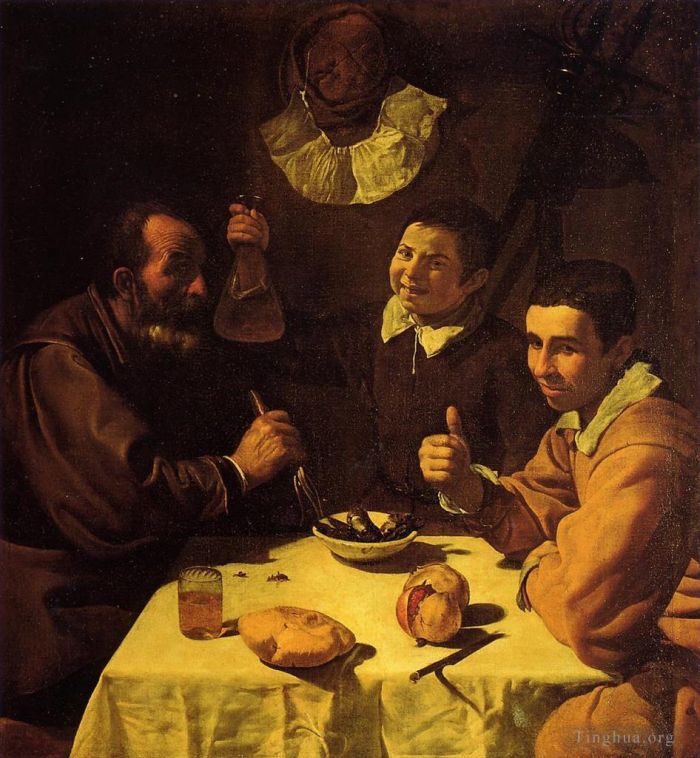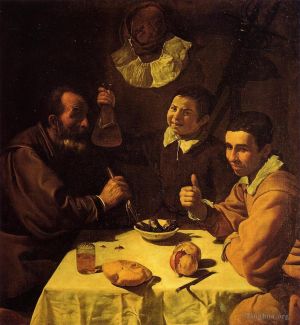The Lunch (Luncheon or Breakfast)
Diego Velazquez
- Price: Price on Request
- Art Type: Oil Painting
- Size:
- English Comments: 0
- International Comments: 0
- Creating Date:
- Introduction and Works of Diego Velazquez >>
Work Overview
- The Lunch (Breakfast)
Spanish: Tres hombres a la mesa (El almuerzo)
Luncheon
Artist Diego Velázquez
Year c. 1617
Medium Oil on canvas
Dimensions 108.5 cm × 102 cm (42.7 in × 40 in)
Location Hermitage Museum, Saint Petersburg
The Lunch is a very early painting by Spanish artist Diego Velázquez, finished c. 1617. The work, an oil painting on canvas, is in the Hermitage Museum of Saint Petersburg.
The painting portrays a table covered by a creased cloth, on which lie two pomegranates and a piece of bread. People attending the lunch include an aged man on the left and a young man on the right, while, in the background, an apparently carefree boy pours wine into a jug.
On the wall in the background hang a white neck-band, a leather bag and, on the right, a sword.
The Lunch is nearly identical to another painting by Velázquez, The Farmers' Lunch (1618).
The Breakfast is among Velázquez's earliest bodegones, painted shortly before the end of his apprenticeship, in 1617 or at the very beginning of 1618. It concentrates with particular intensity on the individual characterization of the men, who are shown half-length and three-quarter length, and they are of different ages. The frugality of their meal obviously does not impair their enjoyment of life. The composition presents a view from above of their expressive faces and hands, the tablecloth, and the physical materiality of the food and drink.
Velázquez did not paint lavish quantities of victuals, but the frugal diet of simple people: there is garlic on tables in his bodegones, with fish and eggs, black pudding, olives and aubergines, cheese, home-made wine and a few fruits, together with kitchen utensils such as a mortar, a bowl or a pottery jug. These Spartan still-lifes and the realistically depicted characters shown in such settings, people with an aura of grave silence even when they are painted in action, convey a sense of self-sufficiency that seems to emanate from the down-to-earth philosophy of the ordinary man in the street.
There is another version of this painting entitled Peasants at the Table in the Szépművészeti Múzeum, Budapest.
- Copyright Statement:
All the reproduction of any forms about this work unauthorized by Singing Palette including images, texts and so on will be deemed to be violating the Copyright Laws.
To cite this webpage, please link back here.
- >> English Comments
- >> Chinese Comments
- >> French Comments
- >> German Comments
- >>Report
- Philip IV
- View of the Gardens of the Villa Medici Rome
- Buffoon Barbarroja
- Pope Innocent X
- Don Luis de Gongora y Argote
- The Surrender of Breda
- Three Musicians aka Musical Trio
- Lady with a Fan
- Two Young Men at a Table
- Old Woman Frying Eggs
- Prince Felipe Prospero
- The Infanta Don Margarita de Austria
- The Toilet of Venus (Venus at her Mirror or The Rokeby Venus)
- Queen Isabel
- Mpther Jeronima de la Fuente
- De Acedo El Primo
- Pablo de Valladolid
- Philip IV in Brown and Silver
- Philip IV Standing
- Philip IV as a Hunter
- Juan de Pareja
- A Dwarf Holding a Tome in His Lap aka Don portrait Diego de Acedo el Primo
- Innocent X
- Young Man 1629
- The Poet Don Luis de Gngora y Argote
- Infante Don Carlos
- Sebastian de Morra
- Democritus
- Infante Philip Prosper dog
- Cardinale Ferdinand
- Portrait of a Man
- The Spinners (The Fable of Arachne)
- The Buffoon Calabazas2
- Philip IV 1624
- Philip IV Standing2
- Saint Paul
- Portrait of the Infanta Margarita
- Vulcan’s Forge
- Philip IV at Fraga
- Infante Philip Prosper
- Portrait of a Little Girl
- Head of a Deer
- Don portrait Diego del Corral y Arellano
- Portrait of a Man with a Goatee
- King Philip IV as a Huntsman
- Miguel Angelo Barber to the Pope
- Court Dwarf Don Antonio el Ingles
- Jester Don Juan de Austria
- The Buffoon Juan de Austria
- The Lunch (Luncheon or Breakfast)
- Young Peasant Girl
- The Temptation of St Thomas Aquinas
- St Ildefonso Receiving The Chasuble From The Virgin
- The Dwarf Francisco Lezcano
- Mercury and Argus
- Portrait of Innocent X
- A Sibyl
- Dona Antonia de Ipenarrieta y Galdos with Her Son
- Las Meninas
- The needlewoman
- Camillo Massimi
- Don Gaspar de Guzman Count of Olivares and Duke of San Lucar la Mayor
- Self
- A Dwarf Sitting on the Floor
- Queen Isabel Standing
- Prince Baltasar Carlos in Hunting Dress
- Supper at Emmaus
- John at Patmos
- Portrait of a Cleric
- Dona Antonia de Ipenarrieta y Galdos and her Son Luis
- Don Cristobal Suarez de
- Philip IV In Armour 1628
- Study For The Head Of Apollo
- Menippus
- Abbess Jeronima de la Fuente
- Francesco II dEste Duke of Modena
- Aesop
- A Young Lady
- Portrait of a Young Man 1626
- Francisco Bandres de Abarca
- Juan Martinez Montanes
- Queen Dona Mariana of Austria
- Josephs bloody coat
- Christ in the House of Mary and Marthe
- Philip IV on Horseback
- 4Velazquez Portrait of the Infanta Margarita
- The Buffoon Pablo de Valladolid
- View of Zaragoza
- Mars
- Maria Teresa of Spain with two watches
- Don Juan Mateos
- Dona Maria de Austria
- Don Gaspar de Guzman Count of Oliveres and Duke of San Lucar la Mayor2
- The Feast of Bacchus (The Triumph of Bacchus or Los borrachos)
- Portrait of Philip IV
- Sibyl
- Saint John at Patmos
- Don Baltasar Carlos with a Dwarf
- The Buffoon Don Cristobal de Castaneda y Pernia aka Red Beard
- The Buffoon Calabazas
- A Knight of the Order of Santiago
- Don Balthasar Carlos
- Saint Anthony Abbot and Saint Paul the Hermit
- THe Waterseller of Seville
- The Farmers Lunch (Peasants at the table)
- Infanta Marguarite Therese
- Prince Baltasar Carlos on Horseback
- Kitchen Scene With The Supper In Emmaus
- The crucified Christ
- The Adoration of the Magi
- Archne A Sybil
- The Sculptor Martinez Montanes
- The Coronation of the Virgin
- Velasquez2
- The Dwarf Don Juan Calabazas called Calabacillas
- Los Borrachos The Triumph of Bacchus
- Allegorical Portrait of Philip IV
- Cardinal Camillo Astalli
- The White Horse
- The Immaculate Conception
- Velasquez1
- Head Of A Girl
- Gaspar de Guzmán Count-Duke of Olivares on Horseback









 Singing Palette
Singing Palette